 |
 |
 |
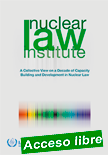 |
Nuclear Law Institute: A Collective View on a Decade of Capacity Building and Development in Nuclear Law
English ¦ STI/PUB/1962 ¦ 276 pages ¦ Date published: 2022
The Nuclear Law Institute (NLI) is one of the main activities within the IAEA's training programme on nuclear law and legislative drafting. With approximately 600 officials trained since 2011, the NLI has made a major contribution to the establishment and enhancement of adequate national nuclear legal frameworks in Member States.
|
This publication is intended to provide information on the background, programme and methodology of the NLI, and its impact on Member States. Reflection on current topics, trends and developments in international and national nuclear law to which the NLI has contributed through the past decade is also included. The publication brings together contributions from NLI organizers, facilitators, lecturers and alumni.
|
 |
 |
IRS Guidelines - 2022 Edition. Joint IAEA and OECD/NEA International Reporting System for Operating Experience (IRS)
English ¦ IAEA Services Series No. 19 (Rev. 1) ¦ 70 pages ¦ Date published: 2022
The purpose of these guidelines is to describe the IRS and to give users the necessary background information and guidance to enable them to produce high quality IRS reports while retaining the effectiveness of the system expected by all Member States operating nuclear power plants. These guidelines supersede the original IRS Guidelines publication issued as IAEA Services Series No. 19 in 2010.
|
As the IRS is owned by the Member States of the IAEA and the OECD/NEA, the IRS Guidelines have been developed and approved by the IRS National Coordinators with the assistance of the Secretariats of the IAEA and the OECD/NEA.
|
 |
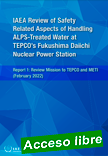 |
IAEA Review of Safety Related Aspects of Handling ALPS-Treated Water at TEPCO’s Fukushima Daiichi Nuclear Power Station. Report 1: Review Mission to TEPCO and METI
English ¦ IAEA ¦ 60 pages ¦ Date published: Feb 2022
The report summarizes the overall progress in the technical preparations for the water discharge. It compiles the initial findings from the Task Force’s first review mission to Japan’s Tokyo Electric Power Company (TEPCO), the Fukushima Daiichi nuclear power station operator, and the Ministry of Economy, Trade and Industry (METI) in February 2022.
|
.
|
 |
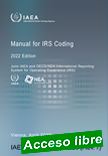 |
Manual for IRS Coding. Joint IAEA and OECD/NEA International Reporting System for Operating Experience (IRS)
IAEA Services Series No. 20 (Rev. 1) ¦ English ¦ 106 pages ¦ Date published: 2022
This publication is the outcome of consultancy meetings held in Vienna in May 2019 and November 2019. It is closely aligned with IAEA Safety Standards Series No. SSG-50, Operating Experience Feedback for Nuclear Installations. The IAEA officers responsible for this publication were H. Morgan and D. Zahradka of the Division of Nuclear Installation Safety.
|
.
|
 |
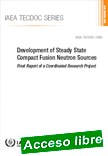 |
Development of Steady State Compact Fusion Neutron Sources
IAEA-TECDOC-1998 ¦ English ¦ 120 pages ¦ Date published: 2022
Fusion neutron sources have many important practical uses, such as irradiation testing of materials and components, facilitating the production of various isotopes such as tritium, driving subcritical cores, characterizing spent nuclear fuel, and manufacturing medical isotopes. All these applications can be potentially improved by achieving higher neutron yields and fluxes in compact fusion neutron sources (CFNSs).
|
This publication is a compilation arising from an IAEA coordinated research project on this topic and presents the project's main results and findings with the aim of supporting stakeholders in the development of CFNSs in the transition from conceptual to engineering design.
|
 |
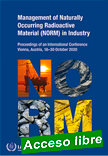 |
Management of Naturally Occurring Radioactive Material (NORM) in Industry
IAEA Proceedings Series ¦ STI/PUB/1998 ¦ English ¦ 90 pages ¦ Date published: 2022
Over the past few decades, many studies have found elevated natural radionuclide activity concentrations in wastes and residues from a wide range of industrial activities that are not part of the nuclear fuel cycle. Member States experienced challenges in finding feasible and implementable approaches for the proper management of such naturally occurring radioactive material (NORM) wastes and residues.
|
This proceedings publication arises from the IAEA conference, NORM 2020, convened to address these issues. The conference was focused on the sharing of experiences in the management of NORM in industrial operations with the aim of contributing to the harmonization of practical approaches and adoption of good practices. This was the first IAEA NORM conference with this focus and builds upon previous events organized by the international community and progress in this area to date worldwide. Unique to NORM 2020 was that it brought together different stakeholders to identify current issues and expected future challenges and possible strategies for dealing with them. Although the conference was focused on industrial operations it also considered the latest technological developments and research work, regulatory requirements, and safety aspects.
|
 |
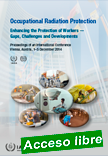 |
Occupational Radiation Protection: Enhancing the Protection of Workers - Gaps, Challenges and Developments
IAEA Proceedings Series ¦ English ¦ STI/PUB/2004 ¦ 536 pages ¦ Date published: 2022
This proceedings publication presents the outcome of an IAEA conference on occupational radiation protection. The conference provided an important opportunity to review recent technical and regulatory developments concerning occupational exposure to ionizing radiation in all facilities and activities.
|
It brought together experts from a wide range of countries and international organizations to report on and discuss the progress made in identifying, quantifying, and managing the radiological risks associated with workplaces. The revision of international basic safety standards, which was completed during the period since the last conference, provided an important backdrop to the presentations and discussion. The publication includes the conference summary, opening addresses, and presentations from the twelve topical sessions and four round table discussions.
|
 |
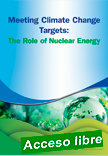 |
Meeting Climate Change Targets: The Role of Nuclear Energy
OECD, Nuclear Energy Agency, 2022. NEA No. 7628. 56 p.
In Meeting Climate Change Targets: The Role of Nuclear Energy, the NEA explores the role of nuclear technologies and their applications toward achieving the globally recognised goal of Net Zero. Governments around the world are urgently seeking to rapidly decarbonise their economies whilst ensuring the security of energy supply. As underlined in the latest IPCC report, achieving Net Zero by 2050 will require an increasingly requisite role for nuclear energy as part of a diversified mix of low carbon technologies.
|
The latest NEA analysis explains how a combination of long-term operation, Generation III new builds, small modular reactors, Generation IV systems, nuclear hybrid energy and hydrogen systems could all contribute to clean energy capacity and emissions reductions between 2020 and 2050.
|
 |
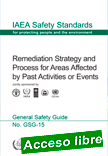 |
Remediation Strategy and Process for Areas Affected by Past Activities or Events
IAEA Safety Standards Series No. GSG-15 ¦ English ¦ STI/PUB/1969 ¦ 201 pages ¦ Date published: 2022
A variety of past activities and events have resulted in contamination of sites and areas by residual radioactive material. In cases where relevant criteria are exceeded, remediation should be implemented to reduce radiation exposure due to contamination, taking into account other non-radiological hazards as appropriate.
|
Remediation includes any actions applied to the contamination itself (the source) or to the exposure pathways to people. This Safety Guide provides recommendations on the planning and implementation of remediation of sites and areas affected by past activities and events based on a systematic, stepwise approach, taking account of the specific characteristics of a given situation and the prevailing circumstances. The Safety Guide is targeted at regulatory bodies, responsible parties, operating organizations and other parties involved in the remediation of sites or areas and contributing to the recovery process to ensure the protection of people and the environment.
|
 |
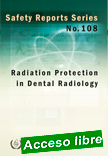 |
Radiation Protection in Dental Radiology
Safety Reports Series No. 108 ¦ English ¦ STI/PUB/1972 ¦ 109 pages ¦ Date published: 2022
X ray imaging is used extensively in dentistry to diagnose symptoms, plan and monitor treatments and to follow up pathoses. This Safety Report provides guidance on meeting the requirements for radiation protection and safety in uses of ionizing radiation in dentistry established in IAEA Safety Standards Series No. GSR Part 3, Radiation Protection and Safety of Radiation Sources: International Basic Safety Standards.
|
It includes guidelines for the justification and appropriateness of medical exposure, and the optimization of radiation protection and safety for patients, carers and dental staff, with detail on considerations relevant for children and pregnant women. Quality assurance, dosimetry and the operation of dental radiological equipment are also discussed. This publication is intended for dental practitioners, referring medical practitioners, medical radiation technologists and other dental health professionals, as well as medical physicists, radiation protection experts, manufacturers and regulators.
|
 |
| |
|
|

|
|
|
| |
|
|
| |
| |
|
|
| |
| |
|
|
| |
| |
|
|
|
| |
| |
